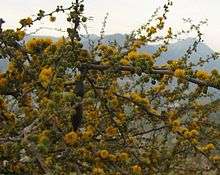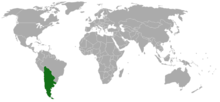Vachellia caven
Vachellia caven (Roman cassie, aromita, aromo criollo, caven, churque, churqui, espinillo, espinillo de baado, espino, espino maulino)[3] is an ornamental tree in the family Fabaceae. Vachellia caven is native to Argentina, Bolivia, Chile, Paraguay, and Uruguay. It grows four to five metres tall and bears very stiff and sharp white thorns up to 2 cm in length. It blooms in Spring, with bright yellow flowers 1 cm to 2 cm in diameter.
| Vachellia caven | |
|---|---|
 | |
| Scientific classification | |
| Kingdom: | Plantae |
| Clade: | Tracheophytes |
| Clade: | Angiosperms |
| Clade: | Eudicots |
| Clade: | Rosids |
| Order: | Fabales |
| Family: | Fabaceae |
| Clade: | Mimosoideae |
| Genus: | Vachellia |
| Species: | V. caven |
| Binomial name | |
| Vachellia caven | |
| Varieties[2] | |
| |
 | |
| Range of Vachellia caven | |
| Synonyms | |
Ecology
Prominent occurrences of V. caven are within the Chilean matorral of central Chile, where the species is a common associate of the Chilean Wine Palm, Jubaea chilensis.[4]
The flowers of V. caven are used as food for bees in the production of honey.[5]
Uses
Erosion control
The tree is used for erosion control.[5]
Ornamental tree
The tree has ornamental uses.[5]
Industrial
Tannin from the seed pods is used for tanning hides.[6] The wood is used as fuel and to make posts for fences. The chief current human use for V. caven is in the production of charcoal.[5]
References
- Seigler DS, Ebinger JE. (2005). "New combinations in the genus Vachellia (Fabaceae: Mimosoideae) from the New World". Phytologia. 87 (3): 139–78.
- Pometti CL. et al. 2007. Morphometric analysis of varieties of Acacia caven: (Leguminosae, Mimosoideae):Taxonomic inferences in the context of Argentine species. Pl.Syst. and Evol.264,239-249
- ILDIS LegumeWeb
- C. Michael Hogan (2008) Chilean Wine Palm: Jubaea chilensis, GlobalTwitcher.com, ed. N. Stromberg Archived 2012-10-17 at the Wayback Machine
- "handbook on seeds of dry-zone acacias". fao.org.
- "Acacia caven". fcien.edu.uy.
External links
- Vachellia caven (as Acacia caven) in Chileflora
- (in Spanish) Vachellia caven (as Acacia caven) photos
- Vachellia caven (as Acacia caven) branch with pods www.fieldmuseum.org
- Vachellia caven (as Acacia caven) branch www.fieldmuseum.org
| Wikimedia Commons has media related to Vachellia caven. |